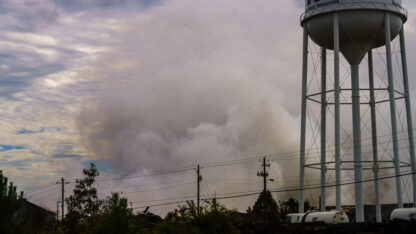Listen to the audio story.
Eli Dickerson faces the Fernbank Forest with Clifton Road just behind him.
“So I was thinking we could sort of follow the creek into the heart of the forest,” he says. “There’s a nice loop we can do around there.”
Dickerson is an ecologist with the Fernbank Natural History Museum. He’s kind of like the curator of this old growth forest.
The museum is reopening the woods to the public Saturday after a four-year restoration effort. They’ll now be part of the museum’s collection that visitors can explore.
On a recent tour, Dickerson points out how the 65 acres are just like one big exhibit into how this region looked, long before European settlers arrived.
“The most obvious thing is the huge, stately tree trunks,” he says. “You can see the different levels in the canopy, and this canopy goes up to 156 feet tall. Pretty tall. That’s about a 16-story building.”
Many of the trees in this forest have lived 200, 300 years, he says, about as old as species around here get.
He moves on to a dense section of woods and points down.
“As you get closer to the ground level in the forest, there’s really an amazing diversity of life,” Dickerson says. “Just in front of us here, I see seedlings of beech trees, seedlings of sweetgum, a really neat plant called devil’s walking stick that is full of thorns.”
This kind of diversity used to be the norm across the South, he says.
Then, Dickerson stops at the side of a small hill – where it turns out, visitors can look even lower. There are a series of little doors built into the hillside.
He opens one and reveals dirt just below the forest floor.
“This is topsoil,” he says. “And it supports all of the diverse plants that we want to be able to thrive and continue to grow in the forest.”
According to Dickerson, in most forests around cities there would be no natural topsoil, or almost none. Farming and development are to blame.
Here, though, he can see at least 12 inches.
“This tells us that this forest ecosystem is old. That’s not just the trees, that’s really the whole ecosystem,” he says. “It has been able to evolve over a long period of time. “
But while the Fernbank Forest may have never been cut down by people, it’s hasn’t remained untouched.
Dickerson makes his way to a pond with a slope on the opposite side to point out the threat the museum’s been trying to combat.
“This is part of our namesake,” he says. “This is what we refer to as the Fernbank Slope.”
Once the slope was filled with different kinds of species of native ferns. With the exception of a dozen trees, the hill is now mostly brown.
“Everywhere that is brown used to be solid green with English ivy,” Dickerson says.
This is why the woods have been closed to the public for the last several years.
Invasive plants introduced by people, like English ivy, monkey grass and Microstegium, crowd out the native plants in the forest. The museum has led volunteers and staff in an effort to get rid of them.
That makes the forest different from other artifacts. To protect it, the museum can’t just let it be.
“If I was to stop all those ecological restoration activities, within a few months to a few years, we would see English ivy, crawling back up the trunks of the trees into the crowns,” Dickerson says. “Eventually they would shade out the trees. The trees would die.”
That could mean the end of this ancient forest, he says.
Nearing the end of the tour, Dickerson says these woods are important – for some reasons many people may already know.
“This forest is helping to provide clean air and clean water,” he says. “It’s also serving as a sanctuary, or a refuge, for not just the animals and plants that are here, but for people who visit.”
That’s really why these 65 acres were preserved here, at the edge of Atlanta city limits. The founder of what would become the museum wanted people to experience them, Dickerson says.
“Although at face value, you might say this looks like the forest in my backyard or down the street, I think there’s a different feeling here. You kind of slow down and think about everything that has happened here in this forest over the years and centuries and millennia.”
One of the main things Dickerson hopes people learn in this exhibit is just that – how to slow down and experience it.
Like us on Facebook


9(MDAxODM0MDY4MDEyMTY4NDA3MzI3YjkzMw004))








